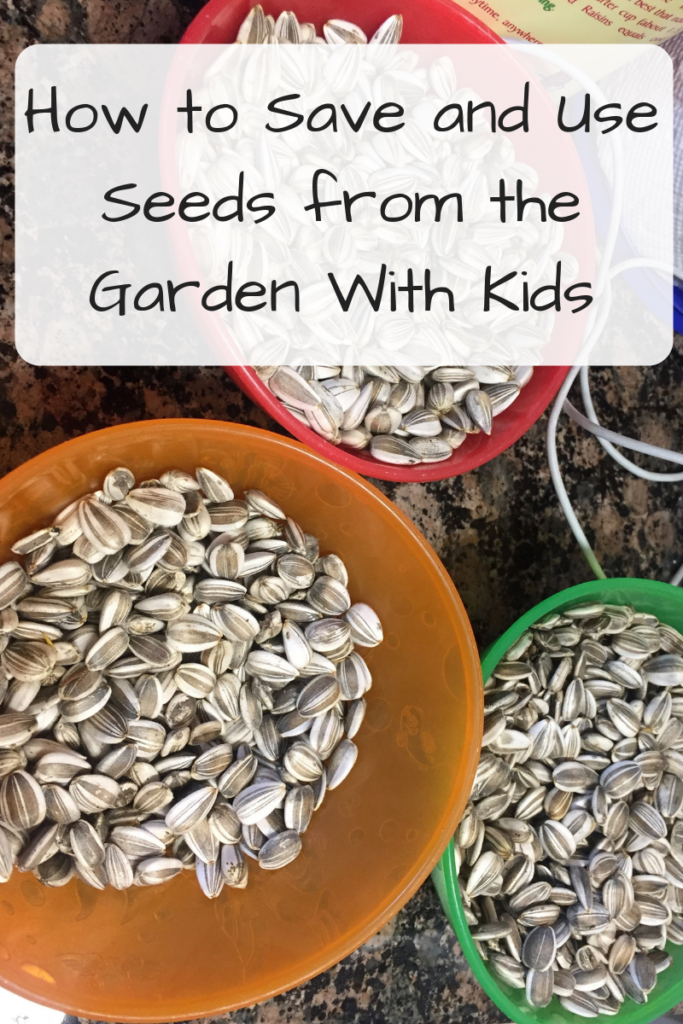
Two huge sunflowers rose out of my children’s garden, their once yellow faces bending down towards the Earth. Holding a serrated knife, I wondered how on Earth I was going to get their seeds out. But I had promised my kids sunflower seeds and sunflower seeds were what I was going to deliver.
Despite my conundrum, saving and using seeds from your garden (or even farmer’s market purchased produce), isn’t that complicated. It’s a great activity to do with kids that you can use to illustrate the life cycle of plants and teach them how to use as much of the plant as possible. It also minimizes reliance on store bought seeds for your garden. After you’ve harvested the seeds, you can save them for next year’s garden, feed them to wildlife, or even cook them off and eat them yourself.
If you’re interested in saving seeds, here are the main steps:
Grow or buy fruits and vegetables that are kid-friendly and produce seeds that are easy to save
Sunflowers are probably the most kid-friendly plant that also produces oodles of seeds. The uber-flowers in our yard were transplants from sprouts my son had grown in preschool. They’re also loads of fun to loop together and create a canopy over a play-space.
Other options include pumpkins, butternut squash, and tomatoes (regular or cherry, although I find cherry less fussy). While not quite as kid-friendly, it’s also very easy to save pepper seeds.
Harvest the seeds
The exact process for harvesting the seeds depends on the plant.
For sunflowers, we cut off the flower and then ran a butter knife along the bottom of the flower to separate the seeds from it.
For any type of winter squash, including pumpkins, just pick the seeds out of the gooey middle. Wipe off the gunk as best you can. Then leave them on a plate to dry overnight. This is a great activity for kids to do when you carve jack o’lanterns!
Tomatoes are a bit more complex, as you have to mimic the natural rotting process tomatoes go through when they fall to the ground. (Which judging from the many self-planted tomatoes in my garden each year, is quite productive.) The basic process is squeezing the insides of several tomatoes into a container with a lid, letting it sit for a couple of days, pour the non-moldy part into another container, rinsing the stuff with water, and gathering the seeds that sink from the bottom. (Those are the good ones.) For more details, the Permaculture Research Institute has very comprehensive instructions. This activity is a great one to do with the kids because mold is both cool and gross. It shows how by mimicking nature’s processes instead of fighting them, we can save ourselves time and energy.
Use the seeds
One option after saving some types of seeds is to use them. You can roast pumpkin, sunflower or squash seeds as a semi-healthy snack. Toss them in olive oil and a little salt and pepper, stick them on a cookie sheet on top of a non-stick surface (we use silicone sheets), and pop them in the oven on 300 degrees for 45 minutes or so. The length of time will vary depending on the seeds.
You can also use them to feed wildlife. We put some of our sunflower seeds in our bird feeder. The birds thought they were great!
Store the seeds
Storing seeds to grow in your garden the next year can save you a bit of money and make you that much more self-reliant. If you are saving seeds for use the next year, either save ones from your own garden or ones from a source that you can get more information from, like a farmer at the Farmers’ Market. Many farmers now use hybrid seeds, which are not as good for saving as heirloom seeds, so it’s good to ask.
If you’re saving seeds from your garden, be aware that you may not get the exact same variety of plant that you planted due to cross-pollination. One year I grew multiple types of peppers and saved the seeds from one plant. I got some very funky looking peppers the next year. Even if you don’t grow multiple varieties, your neighbor down the street may be. There are ways to avoid this, but they take way more work than I am personally willing to put in. It’s more just fun to see what happens!
To store the seeds, the simplest method is to put them in a paper envelope and then put that inside an air-tight container. Store the container in a cool, dry place like a basement or closet.
Saving seeds is a great activity to carry your garden full-circle through the year, especially if you get your kids involved. And hacking down that sunflower ended up being worth it in the end!
For more on gardening with kids, check out How to Plan a Vegetable Garden with Your Kids.
Tomatoes are the easiest seeds to save. Just pick seeds out of the pulp of the tomato you are eating and put them on a paper towel. The pulp sticking to the seed will glue it to the towel, and when it is dry you can write the date and variety on the towel, tear off the bit with seeds on it, and store it with your other seeds.
In the spring, tear off a bit of towel with a seed stuck to it and plant.